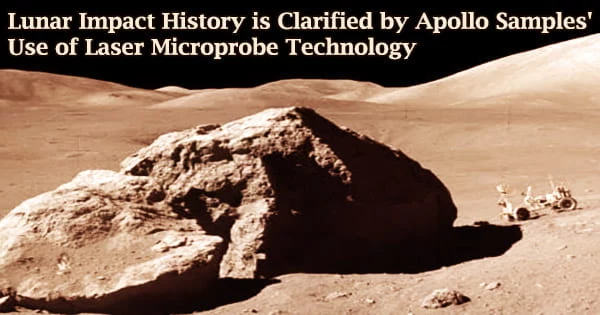Since the last Apollo samples were brought back from the moon more than 40 years ago, those samples have undergone some of the most thorough and in-depth analysis of any geological collection.
Through the innovative use of laser microprobe technology on samples from Apollo 17, a group of researchers lead by ASU researchers has now improved the timeline of meteorite hits on the moon.
The most common geologic process affecting the solid surfaces of planetary bodies in the solar system is impact cratering. The moon’s scarred surface is a physical reminder of the solar system’s long history of meteorite bombardment.
Because the moon is a key surrogate for understanding Earth’s early bombardment history, which has been largely erased by plate tectonics and erosion, and because we can use the lunar impact record to infer the ages of other cratered surfaces in the inner solar system, developing an absolute chronology of lunar impact events is of particular interest.
Apollo 17 samples were examined for argon isotopes by scientists in ASU’s Group 18 Laboratories, led by Professor Kip Hodges, using an ultraviolet laser microprobe connected to a high-sensitivity mass spectrometer.
This is the first time that samples from the Apollo archive have been used with the laser microprobe 40Ar/39Ar technique, despite the fact that it has been used to study samples with complicated textural properties.
The ASU team’s samples are classified as lunar impact melt breccias, which are assemblages of glass, rock, and crystal pieces produced by impacts on the moon’s surface.
When a meteor collides with another planetary body, a tremendous amount of energy is released, part of which shock-heats and melts the target rocks. For some mineral-isotopic chronometers, especially for material melted during impact, these extreme conditions have the ability to “reset the clock.”
Our results emphasize the need for care in how we analyze samples in the context of impact dating, particularly for those samples that appear to have complex, polygenetic origins. This applies to both the samples that we currently have in our lunar and meteoritic collections, as well as samples that we recover during future human and robotic space exploration missions in the inner solar system.
Cameron Mercer
As a result, isotope geochronology of parts of the target rocks that were shocked and heated to the point of melting and then solidified is the main method used to calculate the absolute ages of lunar craters.
Attempts to date samples and relate the results to the dates of specific impact structures may be made more difficult by the possibility that lunar rocks have undergone several impact events over the period of billions of years of bombardment.
According to conventional opinion, the largest impact basins on the moon produced the vast majority of impact melts, hence almost all of the samples that have been dated must be connected to the development of those basins.
Even small craters with sizes of the order of 100 meters can produce impact melts, according to recent photos from the Lunar Reconnaissance Orbiter Camera. It is true that large amounts of impact melt are produced by basin-scale impact events.
For this specific observation, the team’s results have significant ramifications. The findings are released on February 12 in the first issue of Science Advances, the newest publication from the American Association for the Advancement of Science.
“One of the samples we analyzed, 77115, records evidence for only one impact event, which may or may not be related to a basin-forming impact event. In contrast, we found that the other sample, 73217, preserves evidence for at least three impact events occurring over several hundred million years, not all of which can be related to basin-scale impacts,” says Cameron Mercer, lead author of the paper and a graduate student in ASU’s School of Earth and Space Exploration.
Sample 77115 documents a single melt-forming event that occurred about 3.83 billion years ago and was obtained by astronauts Gene Cernan and Harrison Schmitt at Station 7 during their third and final moonwalk.
Sample 73217, which was retrieved at Station 3 during the second moonwalk by the astronauts, contains proof of at least three separate impact melt-forming episodes that took place between 3.81 billion years ago and 3.27 billion years ago. According to the research, a single, tiny sample can hold onto a number of melt products produced by impact events over a period of billions of years.
“Our results emphasize the need for care in how we analyze samples in the context of impact dating, particularly for those samples that appear to have complex, polygenetic origins. This applies to both the samples that we currently have in our lunar and meteoritic collections, as well as samples that we recover during future human and robotic space exploration missions in the inner solar system,” says Mercer.





